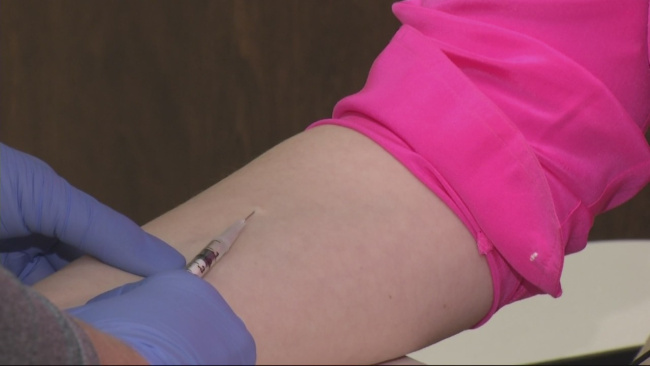During prenatal visits, standard tests are performed in order to track the health of the baby and the future mother. All women who have certain medical conditions should undergo further testing. One of these tests is the tuberculin test which is recommended for all pregnant women who have lived in regions where tuberculosis is a common health condition.

Is It Safe to Have a TB Test While Pregnant?
The tuberculin skin test is considered as a safe test when done in a pregnant woman. However, the test itself is not valid for the diagnosis of tuberculosis during pregnancy, more tests are needed.
How Is the Test Performed?
The tuberculin skin test is administered subcutaneous (under the skin) in the forearm. This skin test consists in injecting a small amount of the tuberculin agent. The injection site should be examined by a doctor two to three days later in order to check for any local reaction.
- If there is a bump more than 10 mm at the injection site in a high-risk area, the test is considered as positive.
- If there is a bump more than 15 mm at the injection site in a low-risk area, the test is also considered as positive.
If the skin test turns out to be positive, it means that you have been previously exposed to tuberculosis at some point in your life.
What If the Test Result Is Positive?
If TB test while pregnant turns out to be positive, you will need to have an X-ray of your chest as well, in order to check for active tuberculosis. During pregnancy, it is safe to have an X-ray of your chest while wearing a lead shield over the abdomen in order to protect the fetus from radiation exposure. The benefits of this examination outweigh the risks of radiation exposure.
If your chest X-ray examination turns out to be normal and you are under 35 years old and healthy, you should receive a course of treatment with isoniazid.
If your chest X-ray examination shows the presence of tuberculosis, you should get your sputum tested for tuberculosis as well. You should also visit a pulmonologist. If the chest X-ray and sputum examinations show the presence of tuberculosis, you will receive treatment even while pregnant. Tuberculosis treatment during pregnancy aims to prevent the developing fetus getting infected with tuberculosis and contracting tuberculosis after birth.
Who Needs to Get Tested?
TB test while pregnant is recommended in the following cases:
- Infected with HIV/AIDS
- Injecting drugs
- Having a daily contact with an infected person with tuberculosis
- Living in a place with high-risk for tuberculosis
- Having daily contact with high-risk patients as a health care worker
- Recommended by your doctor
What Will Happen If You Are Infected with TB While Pregnant?
Tuberculosis is a bacterial infection caused by Mycobacterium tuberculosis, affecting the lungs mostly, but not exclusively. Tuberculosis can affect almost every part of the human body, such as the brain, the bones, the uterus, the kidneys, etc.
Signs and symptoms of the active disease include:
- A persistent cough, lasting longer than 3 weeks
- Fever
- Chest pain
- Fatigue
- Weakness
- Weight loss
- Loss of appetite
- Nausea
- Night sweats
- Breathlessness, etc.
How Will Tuberculosis Affect the Baby?
If pregnant and diagnosed with tuberculosis, it is normally to worry about the effects of this infection on the developing baby inside the uterus. Certain factors play a role when it comes to how the infection affects the baby:
- Pregnancy time
- Disease extent
- Your overall health and well-being
If pregnant and diagnosed with tuberculosis, you have an increased risk for:
- Labor complications
- Preterm labor
- Preeclampsia
- Postnatal hemorrhage, etc.
Tuberculosis infection can easily spread to the developing baby inside your uterus through the umbilical cord. TB test while pregnant is necessary.
How Is TB Infection Treated During Pregnancy?
For pregnant women with latent tuberculosis, treatment with isoniazid for the entire 9 months is recommended. The drug is administered either daily or twice a week. Vitamin B6 supplements are also recommended for pregnant women being treated with isoniazid.
For pregnant women with active tuberculosis, a combination of a couple of medications is necessary, such as isoniazid, rifampin, and ethambutol. These three medications are administered daily for 2 months. The following 7 months of treatment should include isoniazid and rifampin, administered daily or twice a week. A treatment of total 9 months is necessary.
Streptomycin as one of the treatments available for tuberculosis should not be used by pregnant women due to its toxic effects on the developing fetus. Pyrazinamide, another medication for tuberculosis, should also be avoided by pregnant women as there is still not enough information about its effects on the fetus. Other medications to avoid during pregnancy include:
- Amikacin
- Capreomycin
- Kanamycin
- Fluoroquinolones
HIV-infected pregnant women who are also diagnosed with tuberculosis should start the treatment immediately. In these cases, the use of pyrazinamide is recommended as its benefits outweigh its potential risks for the growing fetus.
Once the baby is born, breastfeeding should not be discouraged. The first-line medications for tuberculosis treatment reach only small concentrations in the breast milk. Vitamin B6 supplements are also recommended for women while breastfeeding.
Can My Baby Get Infected from Me Once Born?
This is less likely to occur, as normally after two weeks of medication, you can no longer infect other people. However, your newborn will get tested for tuberculosis. If the baby is infected as well, treatment is needed too. If the baby is not infected, a BCG vaccine will be given based on the immunization chart of your country.
